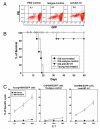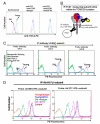B7-H1 expression on old CD8+ T cells negatively regulates the activation of immune responses in aged animals
- PMID: 20375308
- PMCID: PMC3919800
- DOI: 10.4049/jimmunol.0903561
B7-H1 expression on old CD8+ T cells negatively regulates the activation of immune responses in aged animals
Abstract
T cell responses are compromised in the elderly. The B7-CD28 family receptors are critical in the regulation of immune responses. We evaluated whether the B7-family and CD28-family receptors were differentially expressed in dendritic cells, macrophages, and CD4(+) and CD8(+) T cells from young and old mice, which could contribute to the immune dysfunction in the old. Although most of the receptors were equally expressed in all cells, >85% of the old naive CD8(+) T cells expressed B7-H1 compared with 25% in the young. Considering that B7-H1 negatively regulates immune responses, we hypothesized that expression of B7-H1 would downregulate the function of old CD8(+) T cells. Old CD8(+) T cells showed reduced ability to proliferate, but blockade of B7-H1 restored the proliferative capacity of old CD8(+) T cells to a level similar to young CD8(+) T cells. In vivo blockade of B7-H1 restored antitumor responses against the B7-H1(-) BM-185-enhanced GFP tumor, such that old animals responded with the same efficiency as young mice. Our data also indicate that old CD8(+) T cells express lower levels of TCR compared with young CD8(+) T cells. However, following antigenic stimulation in the presence of B7-H1 blockade, the levels of TCR expression were restored in old CD8(+) T cells, which correlated with stronger T cell activation. These studies demonstrated that expression of B7-H1 in old CD8(+) T cells impairs the proper activation of these cells and that blockade of B7-H1 could be critical to optimally stimulate a CD8 T cell response in the old.
Figures






Similar articles
-
Analysis of the role of negative T cell costimulatory pathways in CD4 and CD8 T cell-mediated alloimmune responses in vivo.J Immunol. 2005 Jun 1;174(11):6648-56. doi: 10.4049/jimmunol.174.11.6648. J Immunol. 2005. PMID: 15905503
-
Target-dependent B7-H1 regulation contributes to clearance of central nervous system infection and dampens morbidity.J Immunol. 2009 May 1;182(9):5430-8. doi: 10.4049/jimmunol.0803557. J Immunol. 2009. PMID: 19380790 Free PMC article.
-
Role of PD-1 and its ligand, B7-H1, in early fate decisions of CD8 T cells.Blood. 2007 Jul 1;110(1):186-92. doi: 10.1182/blood-2006-12-062422. Epub 2007 Mar 28. Blood. 2007. PMID: 17392506 Free PMC article.
-
Negative co-receptors on lymphocytes.Curr Opin Immunol. 2002 Jun;14(3):391-6. doi: 10.1016/s0952-7915(02)00341-2. Curr Opin Immunol. 2002. PMID: 11973140 Review.
-
The right place at the right time: novel B7 family members regulate effector T cell responses.Curr Opin Immunol. 2002 Jun;14(3):384-90. doi: 10.1016/s0952-7915(02)00342-4. Curr Opin Immunol. 2002. PMID: 11973139 Review.
Cited by
-
How the ageing microenvironment influences tumour progression.Nat Rev Cancer. 2020 Feb;20(2):89-106. doi: 10.1038/s41568-019-0222-9. Epub 2019 Dec 13. Nat Rev Cancer. 2020. PMID: 31836838 Free PMC article. Review.
-
Plasmacytoid DC from aged mice down-regulate CD8 T cell responses by inhibiting cDC maturation after Encephalitozoon cuniculi infection.PLoS One. 2011;6(6):e20838. doi: 10.1371/journal.pone.0020838. Epub 2011 Jun 10. PLoS One. 2011. PMID: 21695169 Free PMC article.
-
T cell costimulation, checkpoint inhibitors and anti-tumor therapy.J Biosci. 2020;45:50. J Biosci. 2020. PMID: 32345776 Review.
-
Aging-related biomarker discovery in the era of immune checkpoint inhibitors for cancer patients.Front Immunol. 2024 Mar 15;15:1348189. doi: 10.3389/fimmu.2024.1348189. eCollection 2024. Front Immunol. 2024. PMID: 38590525 Free PMC article. Review.
-
Veillonella and Streptococcus are associated with aging of the gut microbiota and affect the efficacy of immune checkpoint inhibitors.Front Immunol. 2025 May 22;16:1528521. doi: 10.3389/fimmu.2025.1528521. eCollection 2025. Front Immunol. 2025. PMID: 40475781 Free PMC article.
References
-
- Linton PJ, Haynes L, Tsui L, Zhang X, Swain S. From naive to effector—alterations with aging. Immunol. Rev. 1997;160:9–18. - PubMed
-
- Malaguarnera L, Ferlito L, Imbesi RM, Gulizia GS, Di Mauro S, Maugeri D, Malaguarnera M, Messina A. Immunosenescence: a review. Arch. Gerontol. Geriatr. 2001;32:1–14. - PubMed
-
- Solana R, Pawelec G. Molecular and cellular basis of immunosenescence. Mech. Ageing Dev. 1998;102:115–129. - PubMed
-
- Miller RA, Garcia G, Kirk CJ, Witkowski JM. Early activation defects in T lymphocytes from aged mice. Immunol. Rev. 1997;160:79–90. - PubMed
-
- Miller RA, Berger SB, Burke DT, Galecki A, Garcia GG, Harper JM, Sadighi Akha AA. T cells in aging mice: genetic, developmental, and biochemical analyses. Immunol. Rev. 2005;205:94–103. - PubMed
Publication types
MeSH terms
Substances
Grants and funding
LinkOut - more resources
Full Text Sources
Medical
Research Materials

